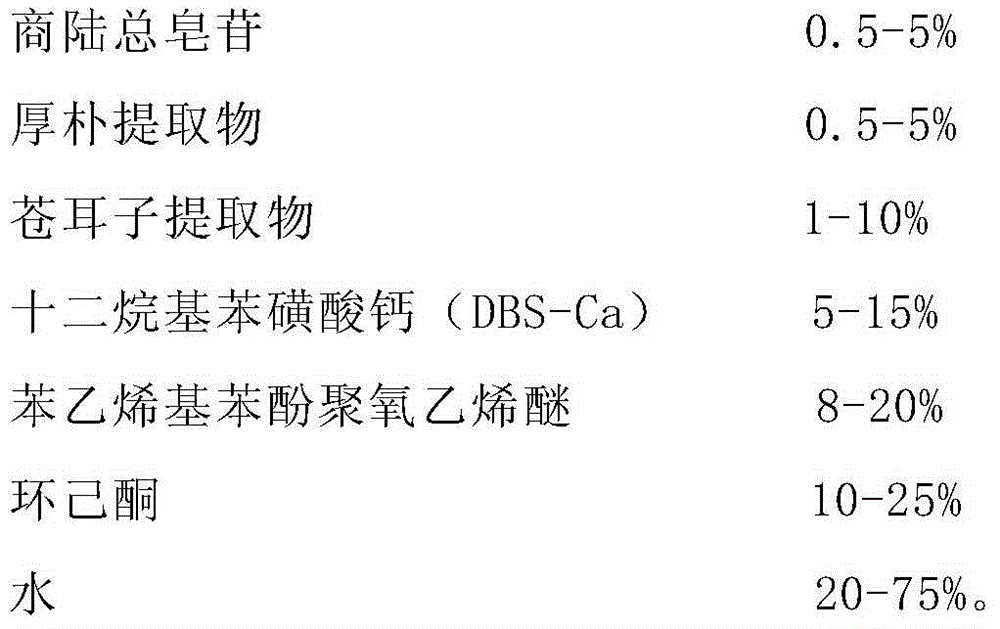Botanical pesticide compound phytolacca acinosa and magnolia officinalis microemulsion and preparation method thereof
A technology of botanical pesticides and microemulsions, applied in botany equipment and methods, plant growth regulators, biocides, etc., can solve problems that do not meet environmental protection, health, affect tobacco leaf quality, and human health hazards, and achieve operational Safe and feasible, fast action speed, and stable production process
- Summary
- Abstract
- Description
- Claims
- Application Information
AI Technical Summary
Problems solved by technology
Method used
Image
Examples
Embodiment 1
[0022] Preparation of Phytophthora saponins: Weigh 10Kg of pulverized Phytophthora root coarse powder, soak and extract 3 times with 70% ethanol solution (volume concentration) of 8 mass times, each extraction for 24h, combine the extracts, filter, and concentrate to obtain Extract, disperse the extract in water of equal quality and heat it to fully dissolve to obtain an aqueous solution. The heating temperature is 80°C. Filter the aqueous solution while it is hot and extract it with n-butanol. Minutes, let it stand overnight, filter to remove activated carbon residue, collect the filtrate, and evaporate to dryness to obtain pokeweed total saponins.
[0023] Preparation of Magnolia Bark Extract: Take Magnolia Bark Powder 10Kg, extract 3 times with 6 times the amount of 65% ethanol solution, extract for 2 hours each time, concentrate the extract to a relative density of 1.2, add an equal volume of 2% NaOH Adjust the pH value of the solution to 10-11, filter after standing for 2...
Embodiment 2
[0027] Preparation of total saponins of Phytophthora saponins: Weigh 10Kg of pulverized Phytophthora root coarse powder, extract once with 50% ethanol solution 5 times by mass, extract for 30 hours, combine the extracts and filter, concentrate to obtain extract, extract Disperse in water of equal mass and heat to fully dissolve to obtain an aqueous solution. The heating temperature is 70°C. Filter the aqueous solution while it is hot and extract it with n-butanol. Combine the n-butanol extracts, add 10 g of activated carbon, heat and reflux for about 5 minutes, and let stand overnight. Remove activated carbon residues by filtration, collect the filtrate, and evaporate to dryness to obtain pokeweed total saponins.
[0028] Preparation of magnolia bark extract: Weigh 10Kg of magnolia bark powder, extract once with 50% ethanol solution of 5 mass times, extract for 3 hours, concentrate the extract to a relative density of 1.1, add an equal volume of 2wt% NaOH solution Adjust the p...
Embodiment 3
[0032]Preparation of total saponins of Phytophthora saponins: Weigh 10Kg of pulverized Phytophthora root coarse powder, extract 4 times with 95% ethanol solution of 10 mass times, each extraction for 10h, combine the extracts and filter, concentrate to obtain extract, and Disperse the extract in water of equal quality and heat it to fully dissolve to obtain an aqueous solution. The heating temperature is 60°C. Filter the aqueous solution while it is hot and extract it with n-butanol. Combine the n-butanol extract, add 100g of activated carbon, heat and reflux for about 30 minutes, and let stand Overnight, filter to remove activated carbon residues, collect the filtrate, and evaporate to dryness to obtain pokeweed total saponins.
[0033] Preparation of Magnolia officinalis extract: Weigh 10Kg of Magnolia bark powder, extract 4 times with 10 mass times of 95% ethanol solution, extract for 1 hour each time, concentrate the extract to a relative density of 1.3, add an equal volume...
PUM
 Login to View More
Login to View More Abstract
Description
Claims
Application Information
 Login to View More
Login to View More - Generate Ideas
- Intellectual Property
- Life Sciences
- Materials
- Tech Scout
- Unparalleled Data Quality
- Higher Quality Content
- 60% Fewer Hallucinations
Browse by: Latest US Patents, China's latest patents, Technical Efficacy Thesaurus, Application Domain, Technology Topic, Popular Technical Reports.
© 2025 PatSnap. All rights reserved.Legal|Privacy policy|Modern Slavery Act Transparency Statement|Sitemap|About US| Contact US: help@patsnap.com



